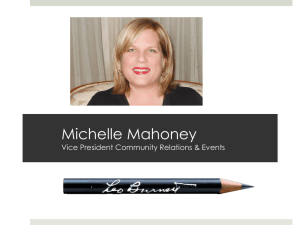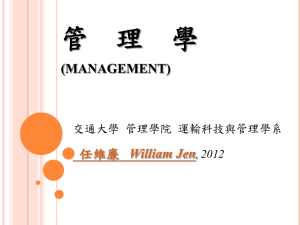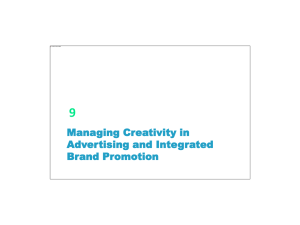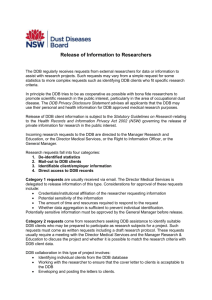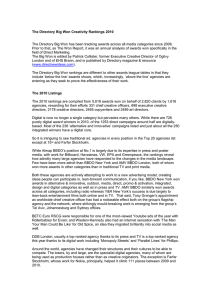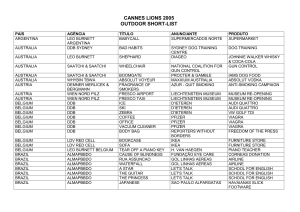Positioning - AdBuzz.com
advertisement
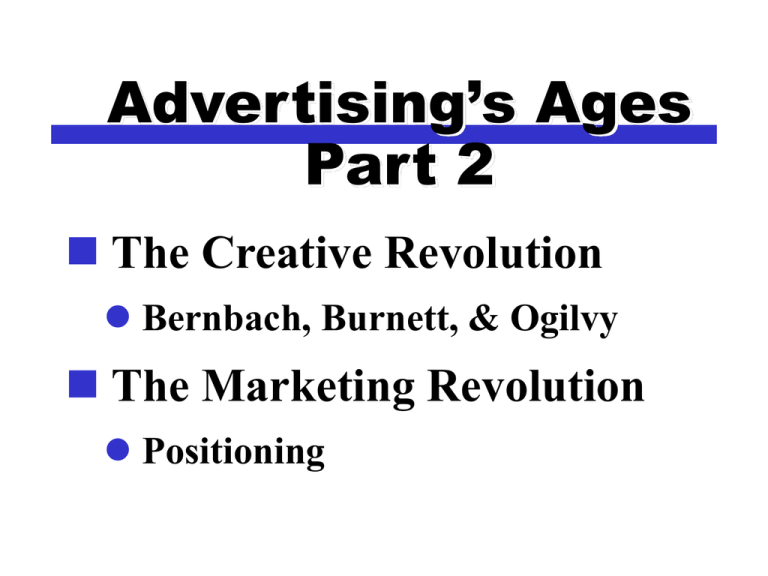
Advertising’s Ages Part 2 The Creative Revolution Bernbach, Burnett, & Ogilvy The Marketing Revolution Positioning The Creative Revolution: 1960-1969 - Cultural Forces Countercultural movements “Break the rules” 1950-1969 - Business Forces A New Breed of Agencies A New communication style Three Influential individuals... Three Key Individuals Bill Bernbach, Doyle Dane Bernbach (DDB) Three Key Individuals Leo Burnett, Chicago, IL “If you reach for the stars, you might not get one, but you won’t come up with a handful of mud, either.” Three Key Individuals David Ogilvy Came from UK to start agency – Ogilvy & Mather Wrote books about advertising Know Who This Is? He’s Paul Rand Very Influential Graphic Designer The key - surprising combinations of words & visuals Paul Rand worked with Bill Bernbach Bill Bernbach Started as writer for head of World’s Fair Meets Paul Rand at small ad agency Moves to Grey becomes Copy Chief 1949 - Starts “DDB” Doyle Dane Bernbach The DDB Style: Ohrbach’s their first account. The DDB Style: Ohrbach’s their first account. The DDB Style: Ohrbach’s their first account. The DDB Style: Ohrbach’s their first account. Levy’s - diversity w. “effective surprise” The DDB Style: Ohrbach’s their first account. Levy’s - diversity w. “effective surprise” Polaroid - dramatic visual demonstration The DDB Style: Ohrbach’s their first account. Levy’s - diversity w. “effective surprise” Polaroid - dramatic visual demonstration Jamaica - one word and a visual... The DDB Style (cont): 3 Key Campaigns: Mobil - “We Want You to Live” The DDB Style (cont): 3 Key Campaigns: Avis - Helped inspire “Positioning” The DDB Style (cont): 3 Key Campaigns: VW - Campaign of The Century The DDB Influence: A New Way of Creating Ads Writer/Art Director Team “The Concept” A New Industry Standard in every award show “Ad Age” chose Bernbach as their “Ad Man of the Century” The Burnett Style “Inherent Drama” Red meat on a red background Leo believed you could find it in almost anything. After all, it was “inherent” The Burnett Style “Inherent Drama” Here’s how Leo’s agency captured the wholesome personality of a Kellogg’s breakfast The Burnett Style “Inherent Drama” Powerful, instinctive, and instinctive long-lasting imagery The Burnett Style “Inherent Drama” The Lonely Maytag Repairman - a dramatic and engagingly human personification of reliability The Burnett Style “Inherent Drama” So, how do you give personality to a can of refrigerated dough? The Burnett Style “Inherent Drama” OK, how about cans of peas and corn? OK then, how about new frozen vegetables? The Burnett Style “Inherent Drama” Tuna fish? Sorry, Charlie, we just want tuna that tastes good. The Burnett Style “Inherent Drama” Cat food? There’s a little bit of Morris in just about every cat owner’s cat. The Burnett Style “Inherent Drama” Cookies? Made by elves who live in a hollow tree, and we almost believe it. The Burnett Style “Inherent Drama” It made Leo’s agency’s campaigns long-lasting and part of our culture “The glacier-like power of friendly familiarity.” Time Magazine chose Leo Burnett as their “Ad Man of the Century” The Ogilvy Approach Now, let’s look at some early work by David Ogilvy. He took classic lessons on copywriting and added his own wit and style The result was advertising that added an extra value for the brand… image The Ogilvy Approach Craftsmanship Research - headline was from a British car magazine Editing - all copy is tight and bright Wit - upscale w/o being a snob Rolls-Royce The Ogilvy Approach Story Value Imagery - one small device - the eye patch adds interest Hathaway Shirts The Ogilvy Approach Story Value Imagery - one small device - the eye patch adds interest Repetition - Ogilvy knew advertising takes time to build - this one device let him tell his story over and over. Hathaway Shirts The Ogilvy Approach “Rules” Here, a similar but different approach for Schweppes - why? Because Ogilvy believed you should Find out what works - and repeat it. Schweppes The Ogilvy Approach Ogilvy grew his agency into a worldclass organization, with New generations of capable management World-class clients Long-term relationships Over time, his agency was the most successful. Marketing Revolution: 1970-1979 Tougher economic times New, more “scientific” tools: Brand Management Market Research Segmentation “Positioning” The Marketing Revolution Brand Management Neil McElroy’s “Big Idea” At P&G (1931) The Idea - manage competitive brands within a company Brand Management becomes standard for marketing organization McElroy becomes head of P&G… Eisenhower’s Secretary of Defense! The Marketing Revolution Marketing Research The Result - companies understand their consumers more accurately The Result - a shift to a marketingdriven perspective from a product or production-driven perspective The Result - manufacturers begin to evolve into marketers The Marketing Revolution Segmentation Product differentiation in response to consumers’ differing needs Maximize potential market share The Marketing Revolution Positioning: Positioning was a new perspective on the new marketplace. Popularized by Jack Trout & Al Ries, former GE Brand Managers There were too many products, and too many messages. Marketers had to deal with this new reality. Positioning: The Positioning authors said advertising had to evolve from hard-sell “reason why” ads... Through image ads... to advertising based on “the mind of the consumer” What was that mind? Positioning: Though the mind of the consumer was overloaded with messages... in most product categories, there were very simple heirarchies... The product ladder Positioning: Within each category, there are four basic types of positions… The Best Position The Against Position The “Niche” Position The New Category The Best Position In most categories, there is a #1 in the consumer’s mind The “Best” Position leverages this Example: Crest The Against Position The “Against” Position defines itself vs. #1. It’s an aggressive and competitive position Example: Avis “We’re only #2. We try harder.” The Against Position The “Against” Position defines itself vs. #1. It’s an aggressive and competitive position Example: 7Up “The UnCola” The Against Position The “Against” Position defines itself vs. #1. It’s an aggressive and competitive position Example: Take The Pepsi Challenge! The Against Position The “Against” Position defines itself vs. #1. It’s an aggressive and competitive position Example: Take The Pepsi Challenge! The Niche Position The “Niche” Position promotes the product along one dimension of superiority Example: AllTemperature Cheer The New Category The New Category is just that. It defines a category that didn’t exist before and then positions the (new) product as the best in that new category. Competition follows. Example: PDAs Positioning Variations: Position by Problem Position by Competitor Then, agencies get bigger Competition toughens The tempo increases... Ad Evolution: 80s & 90s Bernbach’s influence grows… Client mergers continue… Agency mergers begin… Computers and cable… And the tempo increases even more... Discussion Questions In your opinion, who was the most important ad person? In your opinion, what were the most important new ideas? What were your favorite ads?
